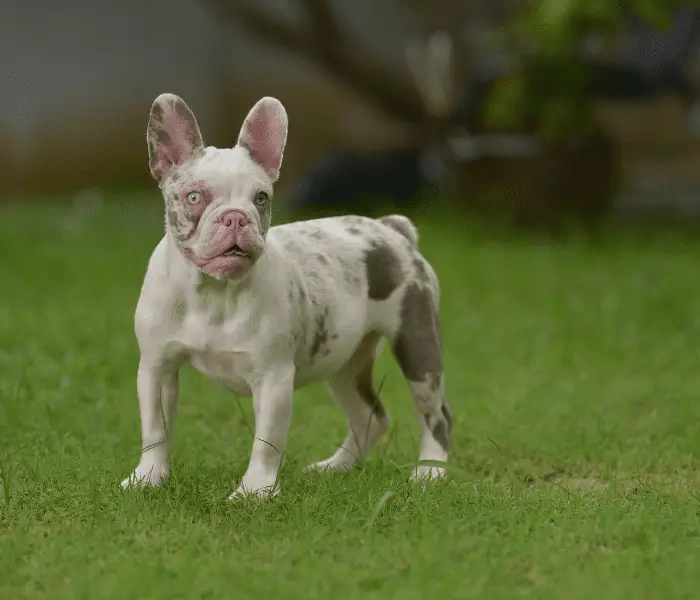There’s no doubt that blue-eyed French Bulldogs are gorgeous, but are they as healthy as traditional Frenchies? This article will dive into everything you need to know about the rare blue-eyed Frenchie.
Blue Eyes in French Bulldogs are commonly seen in merle or piebald dogs. This is because the genes coding for the amount and type of pigment produced will similarly affect the coloring of the coat and the iris in dogs. Blue-eyed dogs also have a higher incidence of being deaf.

What Causes Eyes to Be Blue?
When we talk about eye color, we usually refer to the color of the iris. The pupil is the part of the eye surrounded by the iris. The pupil is always black and expands and contracts in response to the intensity of light the eye is exposed to.
The color of the iris in French Bulldogs is a direct result of the amount and type of pigment called melanin present.
The pigment-producing cells (melanocytes) produce two different types of melanin, namely eumelanin, and pheomelanin. Eumelanin is dark brown or black, and pheomelanin is red or yellow. The amount and type of melanin determine the color of skin, hair, and eyes.
In brown eyes, which are the most common eye color in French Bulldogs, the iris contains a large amount of eumelanin. Hazel eyes (common in color dilute Frenchie coats such as blue) have pheomelanin predominantly with some eumelanin, and blue eyes contain practically no melanin.
Coat Color And Eye Color
The genes for coat color are usually responsible for the amount of melanin in most body parts, including the eyes. This is why specific coat colors are closely associated with eye color.
The amount and distribution of melanin in the iris can also be patchy and differ within patches in a single iris and between the irises of both eyes, similar to what we may see in certain coat patterns.
Blue eyes are more prevalent in coat colors that code for decreased melanin production, such as piebald and extreme piebald.
The merle coat color is also often associated with blue eyes, and merle Frenchies will often have either one blue eye or patches of blue in their eyes (this is called heterochromatic eyes- see below).
Types Of Blue Eyes In French Bulldogs
Heterochromic Blue Eyes
Heterochromia is the term used to describe two different eye colors. The two colors can occur in a single iris or differ between the eyes. This is the most common type of blue eyes in French Bulldogs.

Blue Eyes Caused By Eye Conditions
Eye conditions that cause corneal edema will cause a blueish-grey discoloration of the outer transparent layer of the eye. This is never normal, and you need to have your dog checked out by a vet to find the cause of discoloration as soon as possible, as some of the causes of corneal edema can cause irreversible blindness.
Corneal edema can be a sign of eye conditions, including glaucoma, ulcers, canine hepatitis virus, and certain eye infections.
Other eye conditions that may cause eyes to appear blue include certain eye tumors, advanced cataracts, and certain blood lipid abnormalities.
As a general rule, if you notice a sudden change of eye color in your French Bulldog, you need to have it checked out by a vet.
Blue Eyes In Young Puppies

Most but not all puppies will have dark blue eyes when they first open their eyes at 10-14 days old. However, their eye color will often change at around four weeks old. A puppy’s eye color may change until about six months old.
So, the dark blue eyes we see in very young puppies will usually change as they age and may continue to change until six months.
Are Blue-Eyed French Bulldogs Deaf?
There is a very high correlation between the genes for blue eyes and congenital sensorineural deafness in dogs. This is due to the genes coding for less pigment in the coat color, i.e., extreme piebald and merle (the same genes for blue eyes), affecting the normal development of important inner ear structures.
This deafness often only affects one ear and is often missed unless a BEAR test is done after the puppy turns five weeks old.
It is considered unethical to breed deaf animals due to many behavioral problems such as anxiety and aggression associated with deafness.
To read more on deafness in french bulldogs, please have a look at this article.
Do Blue-Eyed French Bulldogs Have Good Vision?
Although blue eyes are more light-sensitive, and there seems to be an association between early decline in vision and eye color in humans, the vision of French Bulldogs with blue eyes does not differ from the vision of French Bulldogs with brown eyes. Blue eyes, however, are more light-sensitive than dark eyes.
Why Is Only One Eye Blue Or Only Part Of An Eye Blue?
Similar to how the amount of pigment differed in different parts of the skin and coat of dogs, the same can happen in the amount of pigment in the iris. We often see a similar random pattern of the amount of type of pigment in the fur and the iris. (see the photo of the merle French Bulldog puppy above).
Do Blue-Eyed French Bulldogs Have More Health Problems?
Apart from a higher incidence of hearing disability in blue-eyed Frenchies, certain health conditions such as sterility and microphthalmos (abnormally small eyes) have been associated with blue-eyed Frenchies (especially merle and double merle coat colors).
In addition, melanin plays an essential part in protecting cells from damage by UV radiation (i.e., sun exposure). Therefore, reduced melanin in and around the eyes is linked to a higher cancer incidence in most animal species.
Do More Male, Or Female French Bulldogs Have Blue Eyes?
There is no association between eye color and gender in dogs. Blue eyes, although rare, are equally prevalent among male and female French Bulldogs. The genes for blue eyes are not sex-linked.
If you are interested in learning more about the health-related differences between male and Female French Bulldogs, have a look at my article on whether male or female French Bulldogs are healthier.
Are French Bulldogs With Blue Eyes Smarter?
There is no difference in the intelligence of French Bulldogs with blue eyes versus French Bulldogs with brown or hazel eyes.
It is a common preconception that dogs with blue eyes are more intelligent. This stems from the fact that certain dog breeds, such as Huskies, who have been bred to be trainable have blue eyes.
Why Are Blue-Eyed French Bulldogs More Expensive?
Blue eyes are a rare and unique feature in French Bulldogs. Breeders may charge more for puppies with blue eyes due to the rarity of the trait and the high demand for blue-eyed Frenchies.
Blue eyes are a recessive genetic trait meaning both the mom and dad need to carry the gene for blue eyes for it to be expressed in a small percentage of offspring.
Since there are multiple genes on multiple different chromosomes coding for eye color, it can be difficult to predictably breed for blue eyes without compromising other aspects of ethical breeding. A good example of this is the correlation between blue eyes and deafness mentioned above. You can also read more on genes and congenital deafness in this article.
Conclusion
Blue eyes are closely associated with deafness in French Bulldogs. Often this can be avoided through responsible breeding.
Unfortunately, the small and shrinking French Bulldog gene pool is riddled with genetic faults causing these poor dogs to have a poor quality of life. Unfortunately, most French Bulldog owners may not even realize this to be accurate due to many of the health problems Frenchies face having been accepted as ‘normal’ for the breed.
French bulldogs have been described as the least healthy dog breed in multiple dog health and longevity studies.
In my opinion as a vet, rather adopt a non-brachycephalic dog breed and avoid getting a French Bulldog. Not only will you save thousands on vet bills, but your pup will have a much happier, healthier, and longer life!
And if you are still charmed beyond reason by the Frenchie’s stellar personality and cuteness, at least educate yourself so you can give them the best life possible.
In which case, you might find the following article interesting:
- Are Male Or Female French Bulldogs Healthier?
- Why Is My French Bulldog Dragging Their Feet?
- Can French Bulldogs Wag Their Tails? The Frenchie Tail Explained
- Can I Take My French Bulldog On A Jog? Are Frenchies Good Running Buddies?
References
- An, D., Jung, D., Kim, H., Kang, J., Chang, D., Yang, M. and Kang, B., 2013. Brainstem auditory evoked potential findings in a French bulldog with bilaterally congenital sensorineural deafness. Korean Journal of Veterinary Science, [online] 53(4), pp.265-267. Available at: <https //www.kjvr.org/journal/view.php?doi=10.14405/kjvr.2013.53.4.265>.
- Brancalion, L., Haase, B. and Wade, C., 2021. Canine coat pigmentation genetics: a review. Animal Genetics, [on ine] 53(1), pp.3-34. Available at: <https://onlinelibrary.wiley.com/doi/full/10.1111/age.13154#age13154-bib-0023>.
- O’Neill, D., Baral, L, O’Neill, D., Brodbelt, D., and Packer, R., 2018. demography and disorders of the French Bulldog population under primary veterinary care in the UK in 2013. Canine Genetics and Epidemiology, [online] 5(1). Available at: <https //cgejournal.biomedcentral.com/articles/10.1186/s40575-018-0057-9>.
- Packer, R., Hendricks, A., and Burn, C., 2012. o dog owners perceive the clinical signs related to conformational inherited disorders as ‘normal’ for the breed: potential constraints to improving canine welfare. Animal Welfare, [onli e] 21(1), pp.81-93. Available at: <https://helda.helsinki.fi/handle/10138/340402>.
- Sorsby, A. and Davey, J., 1954. Ocular associations of dappling (or merling) in the coat colour of dogs. Journal of Genetics, [online] 52(2), pp.425-440. Available at: <https://www.ias.ac.in/article/fulltext/jgen/052/02/0425-0440>.
- Strain, G., 2004. deafness prevalence and pigmentation and gender associations in dog breeds at risk. The Veterinary Journal, [ nline] 167(1), pp.23-32. Available at: <https://www sciencedirect.com/science/article/abs/pii/S1090023303001047>.
- Westermeyer, H., 2013. When Eyes Get The Blues, World, Small Animal Veterinary Association World Congress Proceedings, Kowloon, Hong Kong. Available at <https://www.vin.com/apputil/content/defaultadv1.aspx?pId=11372&id=5709858&print=1>

